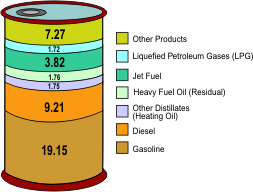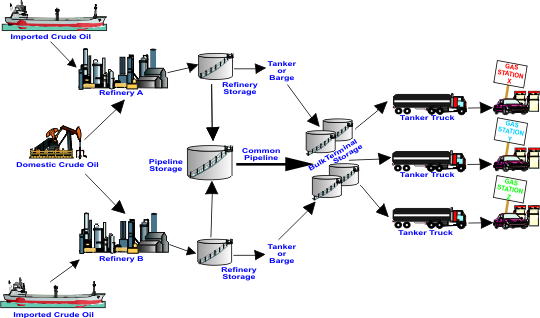Brochure #: DOE/EIA-X059
Release Date: April 2008
Next Release Date: April 2009

 Click on image to down-load a printer-friendly version. Click on image to down-load a printer-friendly version. |
Where Does My Gasoline Come From?
|
The United States consumes about 21 million barrels (882 million gallons) of petroleum products each day, almost half in the form of gasoline used in over 210 million motor vehicles traveling over 7 billion miles per day.
Most gasoline is made from crude oil, formed from the remains of plants and animals that lived hundreds of millions of years ago. These remains were covered with layers of sediment over time. With extreme pressure and high temperatures over millions of years, these remains became the mix of liquid hydrocarbons (an organic chemical compound of hydrogen and carbon) that we call crude oil. Refineries break down these hydrocarbons into different products. These “refined products” include gasoline, diesel fuel, heating oil, jet fuel, liquefied petroleum gases, residual fuel oil, and many other products.
Products Made from a Barrel of Crude Oil, 2007
(Gallons)

Note: A 42-U.S. gallon barrel of crude oil yields between
44 and 45 gallons of petroleum products. These totals
are greater than 42 gallons due to processing gain.
Source: Energy Information Administration |
The most basic refining process separates crude oil into its various components. Crude oil is heated and put into a distillation column where different hydrocarbon components are boiled off and recovered as they condense at different temperatures.
The molecular structure of the input is further changed in processes using heat and pressure as well as catalysts that increase the rate of reactions without being consumed themselves.
The characteristics of the gasoline produced depend on the type of crude oil that is used and the setup of the refinery where it is produced. Gasoline characteristics are also affected by other ingredients that may be blended into it, such as ethanol. Most of the fuel ethanol added to gasoline is made from corn grown in the United States. The gasoline performance must meet industry standards and environmental regulations that vary by location. |
U.S. Petroleum Net Import Sources, 2007
(Percentage)

Source: Energy Information Administration.
|
In 2007 U.S. refineries produced 90 percent of the gasoline used in the United States. Although the United States is the world’s third largest crude oil producer, less than 35 percent of the crude oil used by U.S. refineries was produced in the United States. Net petroleum imports (imports minus exports) accounted for 58 percent of our total petroleum consumption. About 48 percent of our net petroleum imports were from countries in the Western Hemisphere, 18 percent from the Persian Gulf, 22 percent from Africa, and 12 percent from other regions.
|
From Refinery to Consumer
After crude oil is refined into gasoline and other petroleum products, the products must be distributed to consumers. The majority of gasoline is shipped first by pipeline to storage terminals near consuming areas and then loaded into trucks for delivery to individual gas stations. Gasoline and other products are sent through shared pipelines in “batches.” Since these batches are not physically separated in the pipeline, some mixing or “commingling” of products occurs. This is why the quality of the gasoline and other products must be tested as they enter and leave the pipeline to make sure they meet appropriate specifications. Whenever the product fails to meet local, State, or Federal product specifications, it must be removed and trucked back to a refinery for further processing.
Distribution

|
After shipment through the pipeline, gasoline is typically held in bulk storage terminals that often service many companies. At these terminals, the gasoline is loaded into tanker trucks destined for various retail gas stations. The tanks in these trucks, which can typically hold up to 10,000 gallons, usually have several compartments, enabling them to transport different grades of gasoline or petroleum products. The truck tank is where the special additive packages of gasoline retailers get blended into the gasoline to differentiate one blend from another. In some areas, ethanol may be “splash blended” in the tanker to meet environmental requirements. When the tanker truck reaches a gas station, the truck operator unloads each grade of gasoline into the appropriate underground tanks at the station.
Can I tell which country or State the gasoline at my local station comes from?
The Energy Information Administration (EIA) cannot definitively say where gasoline at a given station originated since EIA does not collect data on the source of the gasoline sold at retail outlets. The name on the service station sign does not tell the whole story. The
fact that you purchase gasoline from a given company does not necessarily mean that the gasoline was actually produced by that particular company’s refineries. While gasoline is sold at about 167,000 retail outlets across the nation, about one-third of these stations are “unbranded” dealers that may sell gasoline of any brand. The remainder of the outlets are “branded” stations, but may not necessarily be selling gasoline produced at that company’s refineries. This is because gasoline from different refineries is often combined for shipment by pipeline, and companies owning service stations in the same area may be purchasing gasoline at the same bulk terminal. In that case, the only difference between the gasoline at station X versus the gasoline at station Y may be the small amount of additives that those companies add to the gasoline before it gets to the pump. Even if we knew at which company’s refinery the gasoline was produced, the source of the crude oil used at that refinery may vary on a day-to-day basis. Most refiners use a mix of crude oils from various domestic and foreign sources. The mix of crude oils can change based on the relative cost and availability of crude oil from different sources. |
Grades and Formulations
Service stations usually sell several grades of gasoline: premium, mid-grade, and regular. These grades have different “octane ratings” which reflect the gasoline’s anti-knock properties. The owner’s manual for your car tells you what grade of gasoline your car needs. Most cars can run on regular gasoline, which is the cheapest.
Besides the different grades of fuel, gasoline sold by a single company may differ depending on location or season. Some areas of the country are required to use gasoline that is specially formulated to reduce certain emissions. Environmental programs, aimed at reducing carbon monoxide, smog and air toxics, include the Federal and/or State-required oxygenated, reformulated, and low-volatility (evaporating more slowly) gasolines. These distinct and area specific gasoline requirements mean that gasoline is not a homogenous product nationwide. Gasoline produced for sale in one area may not be suitable for use in another area that has a supply shortage.
Can I tell which companies purchase imported
crude oil or gasoline?
While EIA cannot identify which companies are selling imported gasoline, EIA does collect data on which companies import crude oil and refined products. However, the fact that a given company imported crude oil or gasoline does not mean that those particular imports will end up being sold to motorists as that company’s brand of gasoline. The origin of the crude oil that a refinery processes is determined by market economics at a given time and may change from month-to-month or even day-to-day. Company-level import data can be found at: http://www.eia.doe.gov/oil_gas/fwd/cli.html
|
The Energy Information Administration(EIA) is an independent statistical agency, within the U.S. Department of Energy, whose sole purpose is to provide reliable and unbiased energy information.
For further information, contact:
National Energy Information Center, NEIC
Energy Information Administration
1000 Independence Ave., SW
Washington, DC 20585
Telephone: 202.586.8800, 9:00am-5:00pm Eastern time.
E-mail: infoctr@eia.doe.gov---normal response is 3 business days.
Other consumer-oriented brochures can be accessed on the Web at:
http://tonto.eia.doe.gov/reports/reportsA.asp?type=other
EIA’s Web Site:
www.eia.doe.gov



